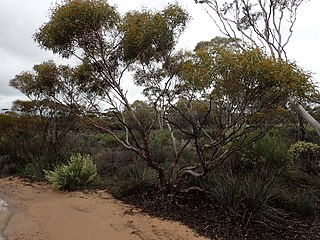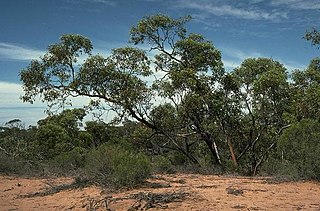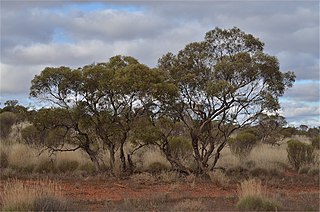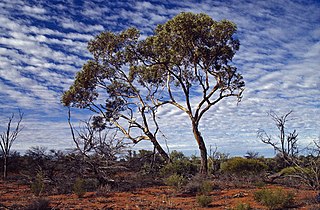
Eucalyptus lansdowneana, commonly known as the crimson mallee or the red-flowered mallee box, is a species of slender stemmed, straggly mallee that is endemic to a restricted area of South Australia. It has rough, fibrous or flaky bark at the base, smooth, grey over creamy-white bark, lance-shaped adult leaves, flower buds in groups of seven, crimson flowers and barrel-shaped fruit.

Eucalyptus dumosa, commonly known as the white mallee, dumosa mallee, or Congoo mallee, is a species of mallee that is endemic to south eastern Australia. It usually has rough, flaky grey bark on the lower trunk, smooth bark above, lance-shaped to curved adult leaves, flower buds in groups of seven, white flowers and cup-shaped, cylindrical or barrel-shaped fruit.

Eucalyptus viridis, commonly known as the green mallee, is a species of mallee or small tree that is endemic to south-eastern, continental Australia. It has rough fibrous or flaky bark on the lower trunk, smooth bark above, linear to narrow lance-shaped adult leaves, flower buds in groups of seven or nine, white flowers and cup-shaped fruit.

Eucalyptus porosa, commonly known as mallee box, Quorn mallee or water mallee, is a species of mallee or a tree that is endemic to southern Australia. It has rough, fibrous or flaky bark on the trunk and larger branches, smooth greyish bark above, lance-shaped adult leaves, flower buds in groups of seven, white flowers and barrel-shaped or shortened spherical fruit.

Eucalyptus intertexta, commonly known as inland red box, western red box, gum coolibah or the bastard coolibah, is a species of tree that is endemic to central Australia. It has rough, fibrous or flaky bark on the base of the trunk, smooth white to brownish bark above, lance-shaped adult leaves, flower buds in groups of seven on the ends of branchlets, white flowers and cup-shaped to hemispherical fruit.

Eucalyptus calycogona, commonly known as the gooseberry mallee or square fruited mallee, is a mallee that is endemic to southern Australia. It has smooth bark, narrow lance-shaped adult leaves, flower buds that are square in cross-section arranged in groups of seven in leaf axils, creamy white, sometimes pink flowers, and fruit that are square in cross-section.
Eucalyptus glomerosa, commonly known as jinjulu, is a species of mallee that is endemic to inland Australia. It has rough, fibrous and flaky bark near the base, smooth bark above, egg-shaped to lance-shaped adult leaves, flower buds usually in groups of seven, cream-coloured flowers and conical to hemispherical fruit. It is mainly found in the Great Victoria Desert of South Australia but also grows in eastern parts of Western Australia.
Eucalyptus gypsophila, also known as the kopi mallee, is a species of mallee that is native to Western Australia and South Australia. It has rough, flaky bark on the lower part of the trunk, smooth light grey bark above, lance-shaped adult leaves, flower buds mostly in groups of between seven and eleven, creamy white flowers and conical to cylindrical fruit.

Eucalyptus phenax, commonly known as green dumosa mallee or white mallee, is a species of mallee that is endemic to southern Australia. It has smooth bark, lance-shaped adult leaves, flower buds in groups of seven or nine, white flowers and cup-shaped to cylindrical fruit.
Eucalyptus semota, commonly known as marymia mallee, is a species of mallee or small tree that is endemic to a small area in central Western Australia. It has rough, flaky to fibrous bark on the trunk, smooth grey or brown bark above, linear to narrow lance-shaped leaves, flower buds in groups of seven or nine, white flowers and conical to cup-shaped fruit.

Eucalyptus sparsa, commonly known as the northern ranges box, is a species of mallee that is endemic to inland Australia, near the border between the Northern Territory, South Australia and Western Australia border. It has smooth pale grey and brown bark, often with rough bark on the base of larger trunks, lance-shaped adult leaves, flower buds usually in groups of seven, white flowers and shortened spherical to conical fruit.

Eucalyptus yilgarnensis, commonly known as yorrell or yorrel, is a species of mallee, rarely a small tree, that is endemic to Western Australia. It usually has rough bark on the trunk, smooth bark above, linear to narrow elliptical or narrow lance-shaped adult leaves, flower buds in groups of seven or nine, white flowers and barrel-shaped fruit.

Eucalyptus calcareana, commonly known as the Nundroo mallee or Nundroo gum, is a mallee or a small tree that is endemic to the south coast of Australia. It has smooth, greyish or cream-coloured bark, lance-shaped or curved adult leaves, flower buds in groups of seven or nine, creamy-white flowers and cup-shaped to conical fruit.
Eucalyptus cajuputea, commonly known as the narrow-leaved peppermint box, is a tree or a mallee that is endemic to South Australia. It usually has rough, flaky bark on the trunk, linear to narrow lance-shaped adult leaves, flower buds arranged in groups of seven to eleven, white flowers and smooth, cup-shaped to barrel-shaped fruit.

Eucalyptus yumbarrana, commonly known as the Yumbarra mallee is a species of mallee that is endemic to South Australia. It has rough, flaky bark on the lower trunk, smooth bark above, egg-shaped to lance-shaped adult leaves, flower buds in groups of seven, creamy white to yellow flowers and shortened spherical to cup-shaped fruit.
Eucalyptus capitanea, commonly known as the desert ridge-fruited mallee, is a species of mallee that is endemic to South Australia. It often has rough, flaky bark on the lower part of the trunk, smooth bark above, lance-shaped adult leaves, ribbed, oval flower buds in groups of seven, cream-coloured flowers and ribbed, urn-shaped fruit.
Eucalyptus infracorticata is a species of mallee that is endemic to a small area of Western Australia. It has rough, flaky or fibrous bark on the lower part of the trunk, broad lance-shaped adult leaves, flower buds in groups of between seven and eleven and short cylindrical fruit.

Eucalyptus socialis subsp. socialis, commonly known as the summer red mallee, is a subspecies of mallee that is endemic to inland south-eastern Australia. It usually has rough bark on the base of the trunk, smooth bark above, lance-shaped adult leaves, flower buds in groups of between seven and eleven, pale creamy white flowers and barrel-shaped to urn-shaped or spherical fruit.

Eucalyptus socialis subsp. victoriensis, commonly known as the red mallee, is a subspecies of mallee that is endemic to southern inland Australia. It usually has rough bark on the base of the trunk, smooth bark above, lance-shaped adult leaves, flower buds in groups of between seven and eleven, pale creamy yellow flowers and barrel-shaped to urn-shaped or spherical fruit.
Eucalyptus socialis subsp. viridans, commonly known as the green-leaved red mallee, is a subspecies of mallee that is endemic to south-eastern Australia. It usually has rough bark on the base of the trunk, smooth bark above, lance-shaped adult leaves, flower buds in groups of between seven and eleven, pale creamy yellow flowers and barrel-shaped to urn-shaped or spherical fruit.

















